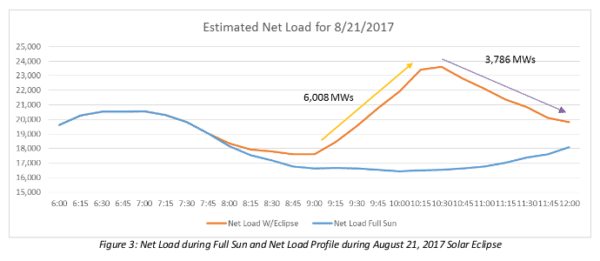On August 21, a total eclipse of the sun will cross the states of Oregon, Idaho and Wyoming, passing within hundreds of miles north of the largest deployment of solar PV in the Western Hemisphere.
California, which got 10% of its electricity from in-state solar last year, will experience this is a partial solar eclipse, with 62-76% of the sun obscured at the peak of the eclipse, depending on the location within the state.
California’s grid operator is already getting ready for this event, which will result in a steep ramp down of solar generation and a corresponding increase in net load as the moon passes in front of the sun starting just after 9 AM, followed by an even steeper ramp up of solar as the eclipse passes, starting at 10:22 AM and lasting until noon.
By August, the California Independent System Operator (ISO) expects to have nearly 10 GW-AC of utility-scale solar online, as well as nearly 6 GW behind the meter. PV output is expected to fall by more than half as the moon passes in front of the sun, and then triple its output as the eclipse passes, resulting in solar generation ramping up nearly 8x as fast as the usual morning ramp.
Despite this dramatic change, California ISO does not expect any reliability issues from the event. The timing of the eclipse is somewhat fortuitous, as net power output also rises during the day, meaning that the late morning ramp down of other resources as solar output returns will be less steep.

Additionally, due to the phenomenon of the “duck curve”, California’s grid operator already has experience managing a steep ramp of electricity output, particularly as the sun goes down. This does not mean there will not be technical challenges.
“Operationally, the solar ramp during the eclipse is expected to increase the burden on other dispatchable resources including the regulating capability of the interconnected power system in terms of available regulation capacity, regulation speed and geographical location of reserves,” notes California ISO.
California ISO has a wide range of tools to deal with the eclipse, including procuring reserves, flexible gas plants, imports of electricity from other states and in-state hydro generation. Regulation reserves alone will be increased from 250 to 400 MW during three hours of the eclipse.
It will also be also a test for forecasting. California ISO is currently obtaining both behind-the-meter and utility-scale solar output forecasts from multiple providers, which will be fed through ISO’s process.
Fortunately for California, Europe has already been through all of this. On March 20, 2015 the continent experienced a partial solar eclipse, which severely limited the output of the nearly 90 GW of solar which was deployed across the continent at this time.
And despite Germany’s nearly 40 GW of installed solar experiencing a 66%-83% eclipse, the German and European grids survived the event with no major incidents.
This content is protected by copyright and may not be reused. If you want to cooperate with us and would like to reuse some of our content, please contact: editors@pv-magazine.com.









As the date of the August 21 eclipse draws near, keep this important safety information in mind: You MUST use special eclipse safety glasses to view a partial eclipse and the partial phases of a total eclipse. To do otherwise is risking permanent eye damage and even blindness. The ONLY time it’s safe to look at a TOTAL eclipse without proper eye protection is during the very brief period of totality when the Sun is 100 percent blocked by the Moon. If you’re in a location where the eclipse won’t be total, there is NEVER a time when it’s safe to look with unprotected eyes. NEVER attempt to view an eclipse with an optical device (camera, binoculars, telescope) that doesn’t have a specially designed solar filter that fits snugly on the front end (the Sun side) of the device. Additionally, never attempt to view an eclipse with an optical device while wearing eclipse glasses; the focused light will destroy the glasses and enter and damage your eyes.